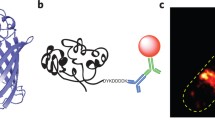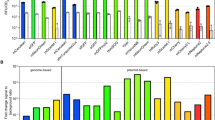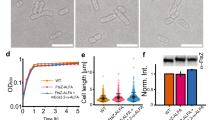Abstract
The advent of genetically encoded fluorescent protein (FP) reporters has revolutionized the ability to track localization of specific proteins in individual cells. Being small and generally lacking structures observable by electron microscopy, bacterial cells have particularly benefited from these technologies, which have demonstrated their high degree of protein organization. To track a protein of interest, the gene encoding the protein needs to be first fused to a gene encoding an FP, with special care to preserve function of the target protein. The localization of the target fusion protein can then be observed either in fixed cells, which preserve the localization at the moment of fixation, or in live cells. Imaging of live cells allows a protein to be tracked spatially as well as temporally. Image analysis and basic quantitation of fluorescence intensities can then be done with freely available software. The locations of multiple proteins can be monitored simultaneously using multiple fluorescent protein tags and can be verified by immunofluorescence if needed. The same specimens can, if desired, be imaged at higher resolution and/or in three dimensions using deconvolution or super-resolution methods. This chapter focuses on the basic methods for localizing proteins fused to FPs in bacteria.
Access this chapter
Tax calculation will be finalised at checkout
Purchases are for personal use only
Similar content being viewed by others
References
Chalfie M, Tu Y, Euskirchen G, Ward W, Prasher DC (1994) Green Fluorescent Protein as a marker for gene expression. Science 263:802–805
Prasher DC (1995) Using GFP to see the light. Trends Genet 11:320–323
Prasher DC, Ekenrode WK, Ward WW, Prendergast FG, Cormier HJ (1992) Primary structure of the Aequorea victoria green-fluorescent protein. Gene 111:229–233
Ormo M, Cubitt AB, Kallio K, Gross LA, Tsien RY, Remington SJ (1996) Crystal structure of the Aequorea victoria green fluorescent protein. Science 273:1392–1395
Yang F, Moss LG, Phillips GNJ (1996) The molecular structure of green fluorescent protein. Nat Biotechnol 14:1246–1251
Drepper T, Eggert T, Circolone F, Heck A, Krauß U, Guterl J-K, Wendorff M, Losi A, Gärtner W, Jaeger K-E (2007) Reporter proteins for in vivo fluorescence without oxygen. Nat Biotechnol 25:443–445
Margolin W (2012) The price of tags in protein localization studies. J Bacteriol 194:6369–6371
Margolin W (2000) Green fluorescent protein as a reporter for macromolecular localization in bacterial cells. Methods 20:62–72
Cohen SE, Erb ML, Selimkhanov J, Dong G, Hasty J, Pogliano J, Golden SS (2014) Dynamic localization of the cyanobacterial circadian clock proteins. Curr Biol 24:1836–1844
Cormack BP, Valdivia RH, Falkow S (1996) FACS-optimized mutants of the green fluorescent protein (GFP). Gene 173:33–38
Snapp E (2005) Design and use of fluorescent fusion proteins in cell biology. In: Bonifacino JS, Dasso M, Harford JB, Lippincott-Schwartz J, Yamada KM (eds) Current protocols in cell biology. Wiley, Hoboken
Giepmans BNG, Adams SR, Ellisman MH, Tsien RY (2006) The fluorescent toolbox for assessing protein location and function. Science 312:217–224
Campbell RE, Tour O, Palmer AE, Steinbach PA, Baird GS, Zacharias DA, Tsien RY (2002) A monomeric red fluorescent protein. Proc Natl Acad Sci USA 99:7877–7882
Landgraf D, Okumus B, Chien P, Baker TA, Paulsson J (2012) Segregation of molecules at cell division reveals native protein localization. Nat Methods 9:480–482
Sastalla I, Chim K, Cheung GYC, Pomerantsev AP, Leppla SH (2009) Codon-optimized fluorescent proteins designed for expression in low-GC gram-positive bacteria. Appl Environ Microbiol 75:2099–2110
Hansen FG, Atlung T (2011) YGFP: a spectral variant of GFP. BioTechniques 50:411–412
Borg S, Hofmann J, Pollithy A, Lang C, Schuler D (2014) New vectors for chromosomal integration enable high-level constitutive or inducible magnetosome expression of fusion proteins in Magnetospirillum gryphiswaldense. Appl Environ Microbiol 80:2609–2616
Matthysse AG, Stretton S, Dandie C, McClure NC, Goodman AE (1996) Construction of GFP vectors for use in Gram-negative bacteria other than Escherichia coli. FEMS Microbiol Lett 145:87–94
Gerlach RG, Holzer SU, Jackel D, Hensel M (2007) Rapid engineering of bacterial reporter gene fusions by using Red recombination. Appl Environ Microbiol 73:4234–4242
Ma X, Ehrhardt DW, Margolin W (1996) Colocalization of cell division proteins FtsZ and FtsA to cytoskeletal structures in living Escherichia coli cells by using green fluorescent protein. Proc Natl Acad Sci USA 93:12998–13003
Weiss DS, Chen JC, Ghigo JM, Boyd D, Beckwith J (1999) Localization of FtsI (PBP3) to the septal ring requires its membrane anchor, the Z ring, FtsA, FtsQ, and FtsL. J Bacteriol 181:508–520
Schneider CA, Rasband WS, Eliceiri KW (2012) NIH Image to ImageJ: 25 years of image analysis. Nat Methods 9:671–675
Levin PA (2002) Light microscopy techniques for bacterial cell biology. In: Sansonetti P, Zychlinsky A (eds) Methods in microbiology. Academic Press, London, pp 115–132
Juarez JR, Margolin W (2010) Changes in the Min oscillation pattern before and after cell birth. J Bacteriol 192:4134–4142
Author information
Authors and Affiliations
Corresponding author
Editor information
Editors and Affiliations
Rights and permissions
Copyright information
© 2015 Springer-Verlag Berlin Heidelberg
About this protocol
Cite this protocol
Rowlett, V.W., Margolin, W. (2015). Localization of Proteins Within Intact Bacterial Cells Using Fluorescent Protein Fusions. In: McGenity, T.J., Timmis, K.N., Nogales, B. (eds) Hydrocarbon and Lipid Microbiology Protocols. Springer Protocols Handbooks. Springer, Berlin, Heidelberg. https://doi.org/10.1007/8623_2015_48
Download citation
DOI: https://doi.org/10.1007/8623_2015_48
Published:
Publisher Name: Springer, Berlin, Heidelberg
Print ISBN: 978-3-662-49129-4
Online ISBN: 978-3-662-49131-7
eBook Packages: Springer Protocols




